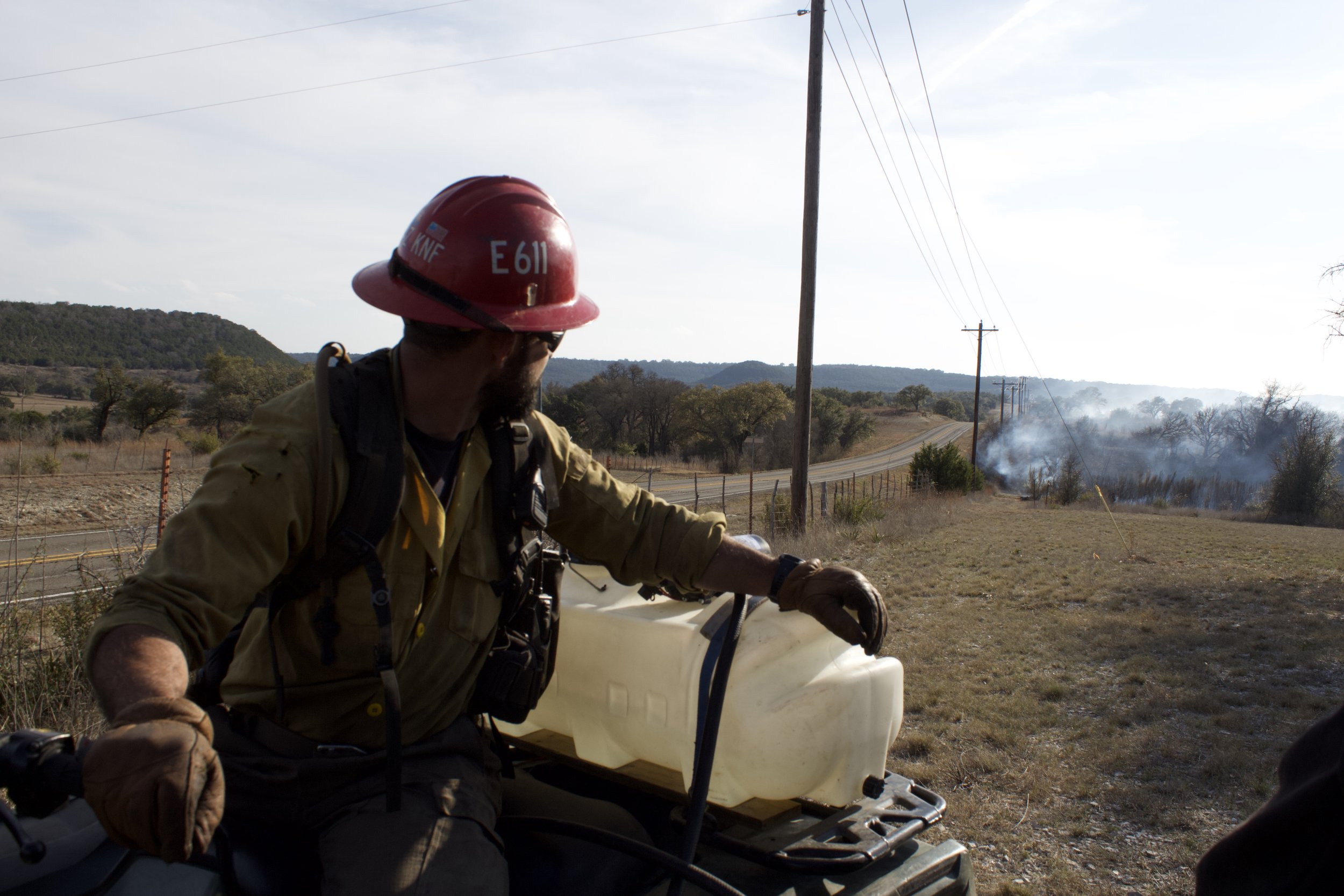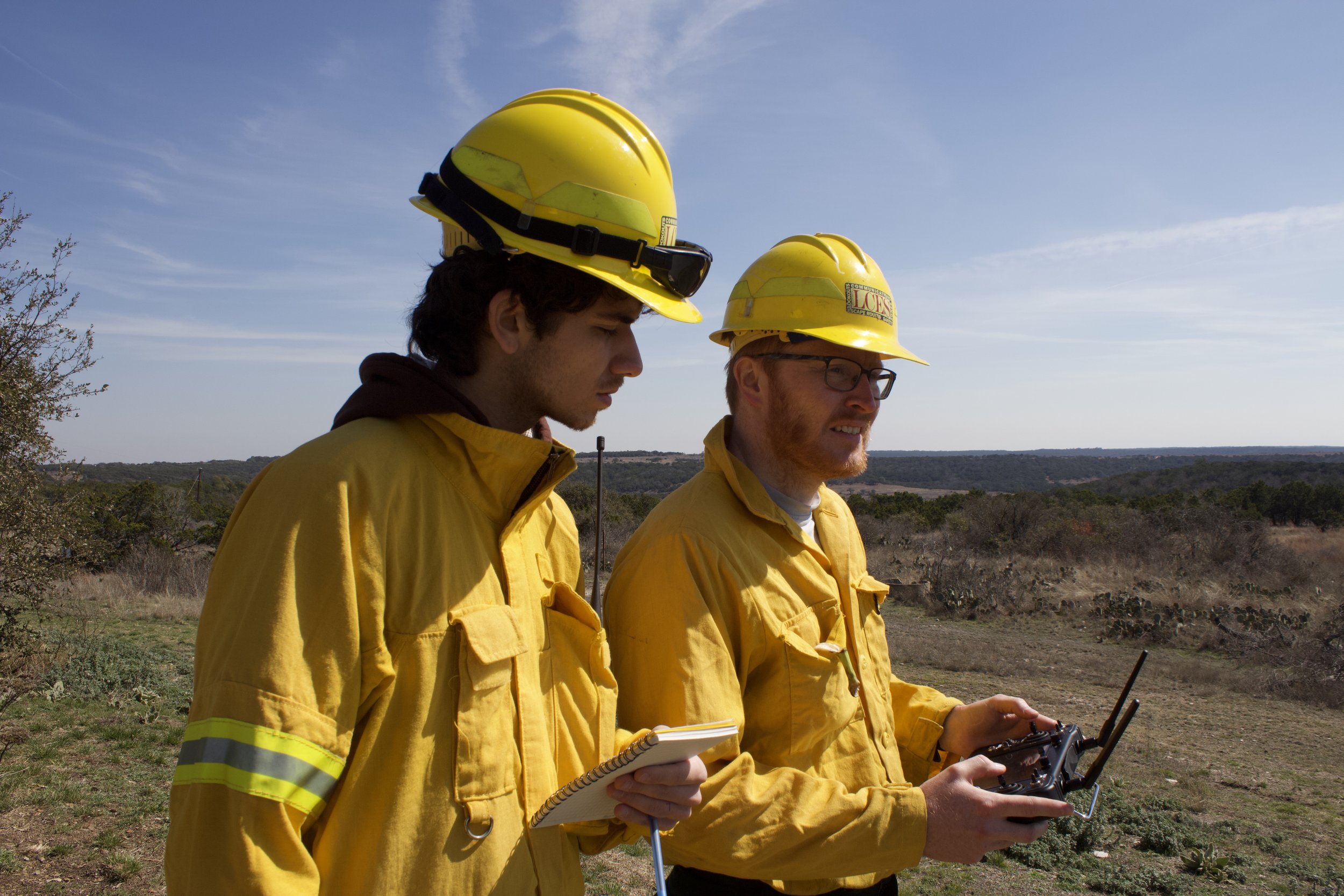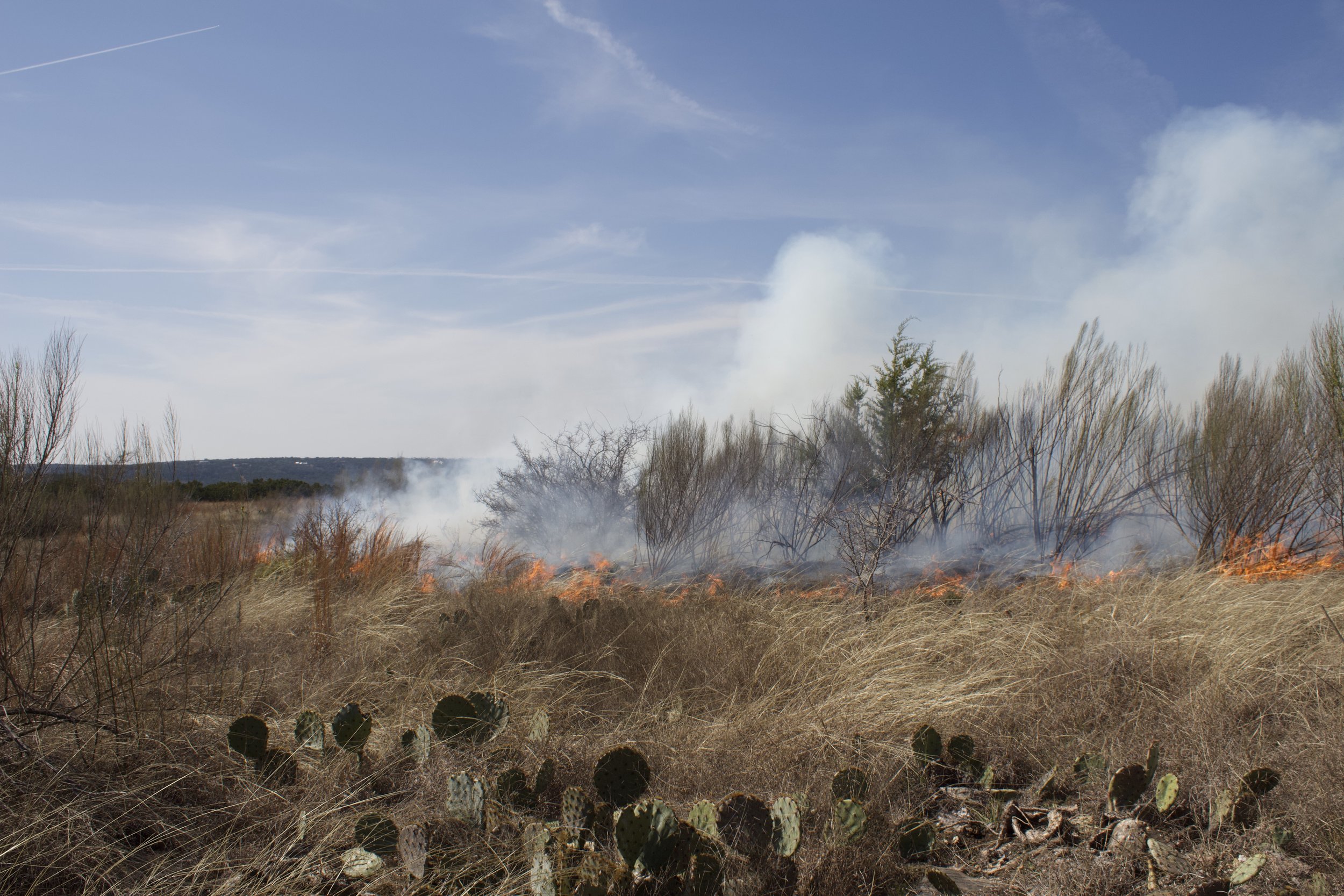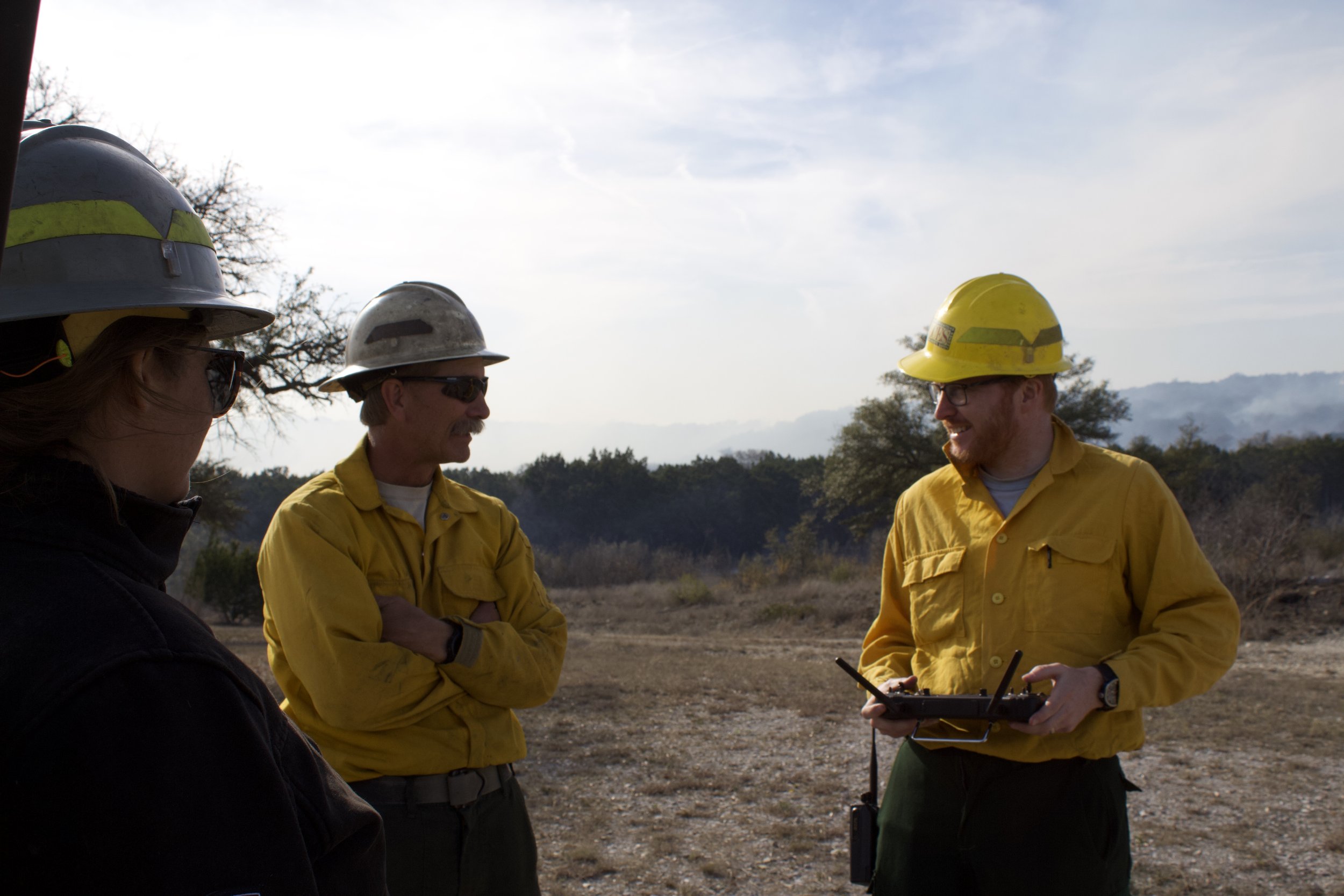Smoke, songbirds and prescribed fires in the Hill Country
Documentary for Friends of Balcones National Wildlife Refuge, published on Reporting Texas. Article written on April 27, 2025. Words and visuals by Angelica Ruzanova.
The fire station at Balcones Canyonlands National Wildlife Refuge resembles a cross between military barracks and a dorm room. Dusty cans labeled “dehydrated water,” unlaced boots a few sizes too big and an untuned guitar clutter the space. Engine Captain Caleb Thyer calls nearby homeowners to notify them of the prescribed burn planned for the afternoon.
The team has been preparing for this day since October and is now loading trucks with drip torches and water canisters. The objective of the operation near Doeskin Ranch is clear: reduce the amount of dry, invasive grasses that fuel wildfires.
“That’s where it all starts and kind of branches down from there,” Thyer said.
In the Texas Hill Country, carefully managed prescribed burns have long been an effective tool for reducing wildfire risk and restoring habitat for bird species threatened by development and climate extremes. But even as the need for them grows, these burns face mounting challenges, including public misconceptions, limited funding and rapid urban expansion.
With tighter budgets, a warming climate and escalating wildlife risks, fire crews, researchers and land managers are working together to sustain prescribed fire programs and prepare the landscape for a more resilient future.
Last year alone, the Austin metro area ranked among the highest in wildfire risk nationally, according to a report by the property analytics provider CoreLogic. Conditions were worsened by adjacent development at the Wildland Urban Interface, the zone where residential housing meets undeveloped vegetation.
These conditions increase the likelihood of catastrophic wildfires, like the 2022 Crittenberg Complex fire near Fort Worth, which burned over 33,000 acres following a six-month drought.
“It’s pretty much the same size and almost the same shape as the refuge,” Thyer said. “It just reiterates that the potential is out there on the right days.”
Balcones conducts biannual burns that aim to eliminate 80% to 100% of thatch, or accumulated dead grasses, in each designated unit. The effort directly supports the refuge’s broader ecological goal of maintaining habitat for the golden-cheeked warbler and the black-capped vireo. The latter was removed from the endangered species list in 2018.
“That's the big target, we're trying to get all of that (fuel) off to create new growth,” Thyer said.
At the burn site, firefighters in yellow jackets, hard hats and safety glasses light the mapped edges of the plot. Plumes of unpredictable smoke rise into the sky, prompting surprised honks from passing cars.
James Thomson, an assistant research professor at the University of Texas’ Bureau of Economic Geology, arrived early to study that smoke. Using drone technology and infrared spectroscopy developed during his graduate studies, Thomson measures emissions to help land managers minimize environmental impacts while conducting effective burns.
In February, he and Jacob Kruel, a graduate student studying soil health, analyzed a prescribed burn in Marble Falls.
“Our objectives there were to acquire data from the fire lines and to improve the understanding of how the fire was moving across that landscape,” he said.
Air quality is the only element of a prescribed burn explicitly regulated by the state. The Texas Administrative Code requires burns to be conducted in wind conditions between 6 and 23 mph to aid smoke dispersal and mandates operations end at least 30 minutes before sunset to prevent smoke from cooling and settling.
“It’s balancing these very complex feedbacks of prescribed burning,” Thomson said. “As well as being very aware that wildfire risk is as high, and doing prescriptions is just one way in which we can help to make the landscape and Hill Country more resilient.”
Historically, much of the region’s native forest was logged for railroads, construction and fencing. The resulting deforestation disrupted the natural balance of the ecosystem, including habitat favored by migratory birds.
“For the vireo, they like their habitat at 5 to 8 feet…in the shin oak,” said Senior Firefighter Eric Glogau. “We use fire as a tool to reset the shin oak and try to keep it all in that stage. It provides a habitat for them.”
However, the burn window in the Hill Country has become increasingly narrow, primarily because of strict regulations aimed at preventing dangerous fire behavior during dry seasons.
In some years, crews are unable to conduct any burns at all, leaving them unable to address the buildup of fallen dead trees from recurring ice storms in recent winters. Without regular treatment, fuels accumulate, elevating wildfire risk and shrinking viable habitat for sensitive species.
Beyond birds, the benefits of controlled burns extend to other native flora and fauna. Fire returns nutrients to the soil in the form of ash, increases sunlight exposure and gives native grasses a competitive edge over invasive species such as King Ranch bluestem.
The sun is setting. More and more bark settles into deep crackling as the remaining fire dissolves into a blue-and-orange flicker. The snakes, rabbits and deer will return to the area in just a few days. Wildflowers will start sprouting shortly after.
Balcones, which spans 27,000 acres, recently adopted a long-term habitat management plan that took five years to produce. Refuge Manager Kelly Purkey, a biologist by training, sees the plan as increasingly important amid shrinking budgets and growing development pressures.
“We have to be thinking 50 years from now,” Purkey said. “We have gotten a lot more neighbors, and they’re a lot closer.”
Because the U.S. Fish and Wildlife Service can’t protect all the necessary land alone, collaboration with private landowners is key. In some cases, the agency splits funding for burns and restoration with willing neighbors.
“We can’t own all the land,” Purkey said. “So we try to work very collaboratively with our neighbors that are willing to manage the landscape.”
Financial limitations are a persistent issue. The agency operates with what Purkey describes as a “lean and mean” budget. Despite managing millions of acres nationwide, staffing remains low, and some conservation objectives outlined in the 1997 Refuge Improvement Act are met by consolidating roles across fewer employees.
“We do what we can with what we have,” Purkey said.
Personnel costs are the refuge’s most significant expense. Just last month, budget shortfalls led to the departure of Biologist Scott Rowin, a team member who once helped geolocate the golden-cheeked warbler populations across the region.
“Over basically every year that I’ve been here, it seems like our funding has decreased,” Rowin said. “Having money available to actually implement habitat restoration projects is very, very challenging.”
Compared to the billions in potential damage from uncontrolled wildfires, prescribed burns offer a cost-effective alternative. CoreLogic’s report estimated $40.6 billion in wildfire-related risk to more than 94,000 homes in the Austin metro alone. As of 2023, that is approximately one in every 11 homes in the Austin-Round Rock-Georgetown area, based on U.S. Census estimates.
Still, smoke remains a concern for nearby communities. The refuge team carefully selects burn days based on state-mandated wind and humidity conditions and takes measures to minimize disruptions.
“It’s kind of a double-edged sword,” Thyer said. “But there is a smoke impact, and we try our best not to put smoke in people’s homes.”
To build trust, the crew provides early notifications, accommodates residents with respiratory sensitivities and carefully monitors wind direction.
“A lot of times, people just think it’s bad and devastating,” Thyer said. “But they don’t understand how fire operates as a tool on the landscape when used in moderate conditions.”








